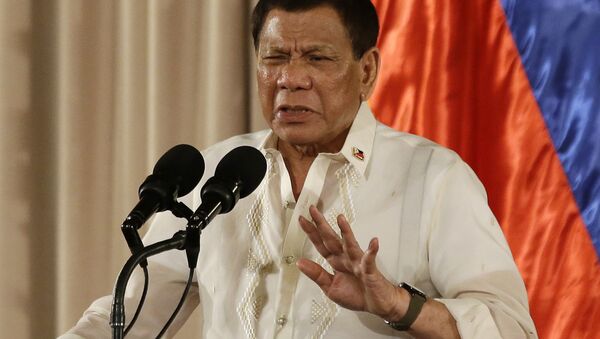Philippines President Rodrigo Duterte said October 12 the Central Intelligence Agency (CIA) should be blamed in the event of his untimely death.
"As for me, I'll be telling Filipinos: if I die, it's America [that's behind it]. It's the CIA. CIA, stop f***ing! One day, I will just drive you away. Either your cahoots here will have to kill me or you have to get out of my country. Choose," the President said.
Moreover, in August, the Philippines National Democratic Front alleged the CIA had been plotting to overthrow the president for veering towards Russia and China in world affairs.
He went on to suggest his internal political opponents should join forces against him into "one command."
"I would be happy really if they would start to merge. These Communists and Liberal Party members. These others who want me out of office, should unite in one group. I think you share the same ideological whatever so things won't get scattered-we can focus on all of you. This is no threat. I said it is my mandated duty to keep this country safe and sound," he concluded.
Historical Foundations
Moreover, US involvement (often via the proxy of the CIA) in the assassination of world leaders since World War II is well-documented.
For instance, the 1975 Church Committee concluded it had "solid evidence" of a plot to assassinate Patrice Lumumba, the first elected Prime Minister of the Republic of Congo, in 1961. Strong hostility to Lumumba, voiced at the very highest levels of government may have been intended to initiate an assassination operation — at the very least, it engendered such an operation.
President Dwight Eisenhower expressed strong concern about Lumumba at an August 1960 meeting of the National Security Council, which was taken by then-Director of Central Intelligence Allen Dulles as implicit authority to assassinate Lumumba.
In 1984, a CIA manual for training Nicaraguan Contras in psychological operations and unconventional warfare — "Psychological Operations in Guerrilla War" — became public. The manual recommended "selective use of violence to neutralize" government officials.
Perhaps most notoriously, Cuban leader Fidel Castro was frequently a target for (ultimately failed) assassinations — perhaps as much as 638 times.
Fabian Escalante, retired chief of Cuban counterintelligence, estimated the number of assassination schemes or actual attempts by the CIA among administrations to be 38 under Eisenhower, 42 under John F. Kennedy, 72 under Lyndon B. Johnson, 184 under Richard Nixon, 64 under Jimmy Carter, 197 under Ronald Reagan, 16 under George H. W. Bush and 21 under Bill Clinton.
In 2006, US Congresswoman Ileana Ros-Lehtinen, a Miami Republican, who had been mooted as future top Republican on the House International Relations Committee, stated she "welcome[d] the opportunity of having anyone assassinate Castro."
There have been frequent allegations of CIA direction, involvement and funding in and of many other assassinations, although strong evidence, much less conclusive proof, has proven elusive in most cases. Nonetheless, the Church Committee concluded the CIA widely employed the so-called tactic of "plausible deniability" during decision-making related to assassinations and other covert actions.
Under this policy, subordinates would deliberately shield higher-ranking officials from any responsibility by withholding full information about planned assassinations, and CIA employees would obtain tacit approval for murderous acts via euphemisms and sly wording in communications.







